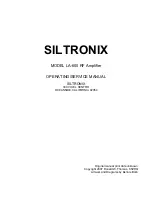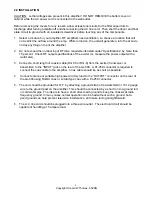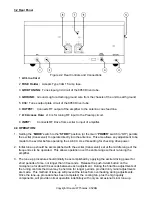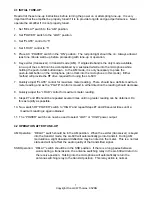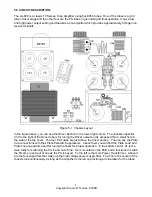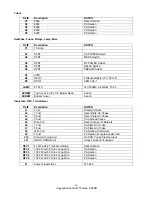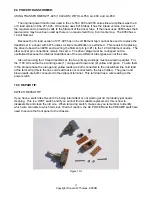
Copyright Donald W Thomas, K5ZRQ
4
2.0
INSTALLATION:
CAUTION: Lethal voltages are present in this amplifier! DO NOT REMOVE the bottom cover or
cabinet while the AC power cord is connected to the wall outlet.
Before removing the covers for any reason, allow at least one minute for the filter capacitors to
discharge after turning amplifier off and disconnecting the AC line cord. Then short the driver and final
plate circuit to ground with an insulated screwdriver before touching any of the components.
1. Select a location for your amplifier. RF amplifiers need ventilation, so choose a location that will
not restrict the air flow around the amp. While turned on, the unit will generate a lot of heat so do
not lay anything on top of the amplifier.
2. Do not exceed the nominal input RF drive requirements listed under “Specifications” by more than
15 percent. Check RF output specifications of the exciter (or, measure the power output with a
wattmeter).
3. Connect a short length of coaxial cable (RG-58 or RG-8) from the exciter (transceiver or
transmitter) to the “INPUT” jack on the rear of the LA-600. A PL-259 connector is required to
connect the coax cable to the amplifier. Coax cable should be as short as possible.
4. Connect antenna or suitable high power dummy load to the “OUTPUT” connector on the rear of
the LA-600 using RG8/U coax or similar type coax with a PL-259 connector.
5. The unit should be grounded for R.F. by attaching a ground strap of coaxial shield or 10-12 gauge
wire to the ground post on the amplifier. This should be connected by a short run to a ground rod
or cold water pipe. The idea is to have a short direct earth ground to keep the chassis at radio
frequency ground. In many cases normal operation can be had without such a ground, but a
good ground can help prevent television interference, and make tuning straightforward.
6. The A.C. line cord should be plugged into a three-wire outlet. The electrical circuit should be
capable of handling a 15 ampere load.

